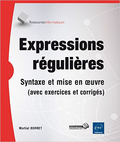GNU/Linux man pages
Livre :
Expressions régulières,
Syntaxe et mise en oeuvre :


GNU/Linux |
CentOS 4.8 |
i386 |
 |
XML::Grove::Subst(3pm) |
 |
XML::Grove::Subst − substitute values into a template
use XML::Grove::Subst; # Using subst method on XML::Grove::Document or XML::Grove::Element: $new_grove = $source_grove->subst( ARGS ); $new_grove = $source_grove->subst_hash( ARG ); # Using an XML::Grove::Subst instance: $subster = XML::Grove::Subst->new(); $new_grove = $subster->subst( $source_grove, ARGS ); $new_grove = $subster->subst_hash( $source_grove, ARG );
"XML::Grove::Subst" implements XML templates. "XML::Grove::Subst" traverses through a source grove replacing all elements with names ’"SUB:XXX"’ or ’"SUB:key"’ with their corresponding values from ARGS (a list) or ARG (a hash), repsectively.
$grove_obj−>subst( ARGS ) =item $subster−>subst( $grove_obj, ARGS )
Search for ’"SUB: XXX "’ elements, where XXX is an array index, and replace the element with the value from ARGS , a list of values. The return value is a new grove with the substitutions applied.
$grove_obj−>subst_hash(
ARG ) =item
$subster−>subst_hash( $grove_obj,
ARG )
Search for ’"SUB:key"’ elements and replace the element with the value from ARG , a hash of values. The hash key is taken from the ’"key"’ attribute of the ’"SUB:key"’ element, for example, ’"<SUB:key key=’foo’>"’. The return value is a new grove with the substitutions applied.
The following template, in a file ’"template.xml"’, could be used for a simple parts database conversion to HTML:
<html>
<head>
<title><SUB:key key=’Name’></title>
</head>
<body>
<h1><SUB:key key=’Name’></title>
<p>Information for part number <SUB:key key=’Number’>:</p>
<SUB:key key=’Description’>
</body>
</html>
To use this template you would first parse it and convert it to a grove, and then use ’"subst_hash()"’ every time you needed a new page:
use XML::Parser::PerlSAX;
use XML::Grove;
use XML::Grove::Builder;
use XML::Grove::Subst;
use XML::Grove::PerlSAX;
use XML::Handler::XMLWriter;
# Load the template
$b = XML::Grove::Builder->new();
$p = XML::Parser::PerlSAX->new( Handler = $b );
$source_grove = $p->parse( Source => { SystemId => ’template.xml’ } );
# Apply the substitutions
$new_grove = $source_grove->subst_hash( { Name => ’Acme DCX-2000 Filter’,
Number => ’N4728’,
Description => ’The Best’ } );
# Write the new grove to standard output
$w = XML::Handler::XMLWriter->new();
$wp = XML::Grove::PerlSAX->new( Handler => $w );
$wp->parse( Source => { Grove => $new_grove } );
Ken MacLeod, ken@bitsko.slc.ut.us
perl(1), XML::Grove(3)
Extensible Markup Language ( XML ) <http://www.w3c.org/XML>
 |
XML::Grove::Subst(3pm) |  |